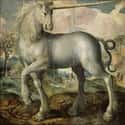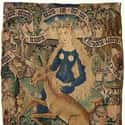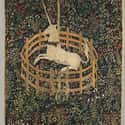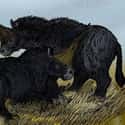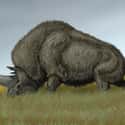-
(#2) Elasmotherium Were Not At All Majestic Or Cute
Since Elasmotherium were related to rhinoceros and believed to be covered in thick hair, they resembled mammoths more than magical horses. As herbivores, they had large, flat teeth and scientists suggest most of their weight was placed on their front legs, giving them a body structure similar to bison.
According to skeletons that have been found, they measured up to 16 feet long with a shoulder height of almost seven feet. At a possible weight of up 10,000 pounds, Elasmotherium was comparable in size to a modern rhino. Imagine that running on a rainbow.
-
(#6) According To Legend, Unicorns Had Super Powers And Were Attracted To Virgins
Although legends claim unicorns are impossible for humans to tame, they are also one of the only mythological beasts that don't want to hurt us. This fact has earned unicorns respect and admiration, as well as a laundry list of other idealized traits including silvery hair, long manes with magical properties, and an all-powerful horn.
Unicorns also became a symbol of purity and were associated with virgins. Even Leonardo da Vinci bought into the unicorn myth and created at least one drawing that featured a unicorn, claiming virgins were the perfect bait to use when hunting them.
-
(#5) Our Image Of Unicorns Evolved From A Creature Allegedly Seen In India
The first known mention of unicorns in history appeared to humans in India. Each sighting seemed to mention the same details, such as four legs with hooves, long manes, white hair or fur, and of course a single horn on its head.
When the Bible was being translated into Greek, the word for "unicorn" was allegedly a mistranslation of the Hebrew word for "wild ox" which also may have played a part in the legend.
Thanks to writers and artists with vivid imaginations taking all the stories from around the world into account, the image of a graceful horse emerged. The popularity of unicorns is most likely due to this idealized image since it's a lot more glamorous than a hairy rhino-mammoth.
-
(#3) Humans Might Have Actually Seen Them
Although Elasmotherium was discovered many years ago and thought to be a possible reason for the unicorn myth, one find made that theory a lot more interesting. In 2016, researchers discovered bone fragments in what is now Kazakhstan that suggest Elasmotherium lived longer than previously believed.
Originally, scientists thought the beasts had gone extinct about 350,000 years ago, long before any humans were around.
Thanks to radiocarbon dating, the findings place the age of Elasmotherium around 29,000 years ago, meaning our human ancestors may have been their neighbors. Scientists believe this could suggest Elasmotherium really might have been the inspiration for unicorn legends.
-
(#4) The Horns Of Elasmotherium Were Not Very Spectacular
Researchers believe the horn of Elasmotherium was made of keratin, the same substance that makes up human fingernails. Unfortunately, keratin is like flesh and dissolves at a much faster rate than bone, so nobody has discovered any actual Elasmotherium horns.
Scientists used later relatives of rhinoceros to guess at the size and shape of the Elasmotherium's horn, believing it to be possibly up to six feet long.
Experts think the horn was used to gain access to food and water by digging holes and extracting roots and other plants. It was most likely also used for self-defense as well as attracting mates while competing with other males for the attention of females.
-
(#1) Scientists Proved 'Unicorns' Existed By Discovering Bones And Partial Skulls
Scientists proved there were three species of Elasmotherium, finding teeth, jaws, and bones in Siberia and Russia in the early 19th century and more in Asia 100 years later. The creature's name is Greek for "thin plate beast" and the skulls have led scientists to believe Elasmotherium was the predecessor to the rhinoceros of today.
These beasts were common throughout Eurasia, and while a few complete skeletons have been unearthed, most discoveries consist of teeth and skull fragments. The skulls feature a round dome on the forehead area where scientists believe there were horns.
New Random Displays Display All By Ranking
About This Tool
There is a
unicorn-like mammal in history records. It was extinct about 29,000 years ago, and its existence is still a mystery for humans. Scientists once found a well-preserved skull in Kazakhstan, it is an extinct rhino and a herbivore that feeds on grass. Scientists have concluded through a large amount of data research that unicorns may have lived in the same age as the ancestors of modern people.
It is speculated that the cold and freezing climate caused plants can not to survive, which caused the herbivorous ancient rhios to disappear from the earth. Here you could find 10 fun facts about these scary and large unicorn-like animals.
Our data comes from Ranker, If you want to participate in the ranking of items displayed on this page, please click here.










